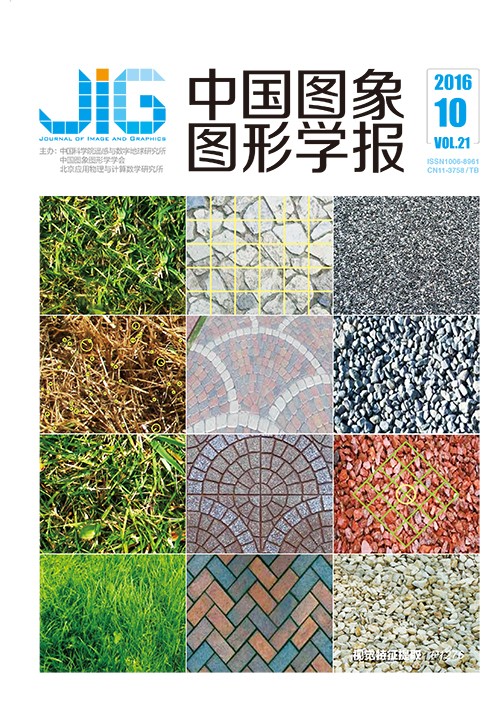
前背景骨架区域随机点对策略驱动下的车标识别方法
摘 要
目的 现有的车标识别算法均为各种经典的图像特征算子结合不同的分类器组合而成,均未分析车标图像的结构特点。综合考虑车标图像的灰度特征和结构特征,提出了一种前背景骨架区域随机点对策略驱动下的车标识别方法。方法 本文算法将标准车标图像分为前景区域和背景区域,分别提取前、背景的骨架区域,在其中进行随机取点,形成点对,通过进行点对的有效性判断,提取能表示车标的点对特征。点对特征表示两点周围局部区域的相似关系,反映了实际车标成像过程中车标图案部分与背景部分的灰度明暗关系。结果 在卡口系统截取的19 044张车标图像上进行实验,结果表明,与其他仅基于灰度特征的识别方法相比,本文提出的点对特征识别方法具有更好的识别效果,识别率达到了95.7%。在弱光照条件下,本文算法的识别算法效果同样优于其他仅基于灰度特征的识别方法,识别率达到了87.2%。结论 本文提出的前背景骨架区域随机点对策略驱动下的车标识别方法,结合了车标图像的灰度特征和结构特征,在进行车标的描述上具有独特性和排他性,有效地提高了车标的识别率,尤其是在弱光照条件下,本文方法具有更强的鲁棒性。
关键词
Vehicle logo recognition based on randomly sampled pixel-pair feature from foreground-background skeleton areas
Yu Ye, Nie Zhenxing, Jin Qiang, Wang Jiangming(VCC Division, School of Computer and Information, Hefei University of Technology, Hefei 230009, China) Abstract
Objective Most of the existing vehicle logo recognition (VLR) approaches simply combine traditional image features with different classifiers, such as template matching, HOG(histogram of oriented gradient)/SVM(support vector machine), HOG/KNN(k-nearest neighbor), SIFT(scale-invariant feature transform)/SVM, and radial Chebyshev moments/SVM, but they do not consider structure features of vehicle logo image. Vehicle logo images have distinct structure information, which is the significant clue for VLR. Considering both their gray and structure features, this study proposes a new VLR approach based on pixel-pair features that are randomly sampled from foreground-background skeleton areas. Method First, a standard vehicle logo image is partitioned into foreground and background areas. Second, the skeleton areas of both foreground and background are extracted, which contracts foreground and background areas, because pixels in skeleton areas are more stable. Third, pixels are randomly selected from the two skeleton areas, forming pixel pairs by cross-matching that can obtain more pixel pairs. Then, through pixel-pair validation, accepted pixels are selected to express vehicle logo features. Features express similarity of local areas centered on both pixels, which reflect the gray relationship of logo and background areas after the imaging process. Pixel-pair validation has two crucial rules. One is that the pixel pair in a different sample of the same class has the same similarity relationship; and the other is that the pixel pair in a different sample of a different class has a different similarity relationship. Last, the connection relationship is introduced during classification. Through the connection relationship, independent pixel pairs, which contribute to vehicle logo recognition, can be aggregated. Result Experimental data derived from 19 044 vehicle logo images are captured by surveillance cameras in the real world. This image group is called Test Set 1. To test the performance of different methods under weak illumination, 2 326 vehicle logo images with weak illumination are selected in Test Set 1, which is now called Test Set 2. Experiment shows that compared with recognition results based on other image features, the method based on the proposed feature can achieve higher recognition performance. Test Set 1 has a 95.7% recognition rate. Under weak illumination, our method attains an 87.2% recognition rate on Test Set 2. Conclusion Considering both gray and structure features of vehicle logo images, we propose a new VLR approach based on pixel-pair features, which are randomly sampled from foreground-background skeleton areas. Pixel-pair feature extraction process fully considers the logo shape, which makes this feature distinctive and exclusive. Experiments show that our method attains a higher recognition rate compared with traditional VLR methods. Our method has shown strong robustness especially under weak illumination.
Keywords
vehicle logo recognition pixel pair feature foreground and background areas skeleton area random sampling cross-matching
|



 中国图象图形学报 │ 京ICP备05080539号-4 │ 本系统由
中国图象图形学报 │ 京ICP备05080539号-4 │ 本系统由